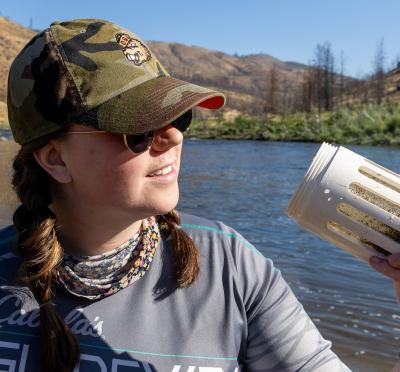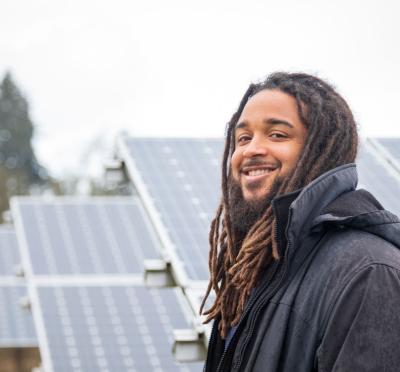In 2007, Dominique Bachelet organized a climate change conference in Portland for The Nature Conservancy. “People would tell me, even years later, ‘Oh yeah, I remember that conference. I don’t remember who presented what research, but the art show was really cool!’” Bachelet said. The juried art show featured work by professionals and children.
Bachelet, an artist herself, was not surprised. She professes a deep faith in art’s ability to touch people in ways that words alone cannot. “I’ve used art as an effective medium to communicate research for a long time,” she said. “In the climate change classes I teach, some students who struggle with writing assignments respond much more positively to assignments that require graphic elements. It’s a powerful tool.”
To channel that power, Bachelet, who sits on the Corvallis Arts Center exhibition committee, proposed an exhibition about climate change. The show, titled “What Will Nature Do?” ran at the center in the fall of 2021, with Bachelet serving as guest curator.
The call to artists stipulated, naturally, that submissions connect with climate change — but it also required artists to emphasize optimism and nature’s resilience. The exhibition was, it said, “an exciting opportunity to distance ourselves from the standard doom and gloom messages and gather a deeper insight into the complexities and opportunities of climate change.”
To be clear, Bachelet isn’t saying that human-caused climate change is good; she’d prefer that it wasn’t our reality. “The media are always telling us that climate change means the end of the world,” Bachelet said. “But there are other ways to view what’s happening, particularly how nature has adapted.”
Some of her colleagues wondered if it was disingenuous to ask artists to find a positive theme within such a grave threat, but she rejected the notion. “We all know bad things are happening because of climate change,” Bachelet said. “But change is constant. Nature is always adapting. We need to adapt as well.”
For inspiration, she coordinated a lecture series in which nine climate change scientists shared their ideas about how nature’s resilience offers hope for the future. Artists were urged to watch at least a couple of the lectures before producing and submitting their work, and write a brief explanation about which one had the most influence on their entry.
For example, a submission by Portland artist Sally Finch, titled “Water temperature models, Upper Middle Fork John Day River,” was inspired by a lecture about how adding shade was the most effective way to cool stream water and preserve salmon habitat, even as air temperatures warm. Her interpretation of the research is seen as colored bands that move from visually warm to cool as increasing foliage shades the river. Finch also spent about two months penciling in thousands of barely visible data points onto the painted canvas.
Notes left by visitors during the show confirm that the art left a strong impression. One wrote: “A powerful exhibit. I felt very moved.” Another jotted down: “New ideas I never thought about.” A third said the show represented “a beautiful overlap between science and art.”
The exhibition also included a second series of 10 talks about how art and science inform one another. Organizing presentations was the easy part of Bachelet’s work as a curator. Much harder was convincing artists to consider a positive depiction of climate change — or at least offer a different take on it.
“I asked artists to sit back, watch, and pay attention to how nature is dealing with this adversity — where is it succeeding? — then focus on that and use their imagination and their art to answer the question, what will nature do?” said Bachelet, who sold one of the two watercolors she displayed at the exhibition.
Even before the show opened, Bachelet was working on another, “Imagine the Future.” Artists were asked to choose any theme that felt right to them, whether it was the environment, social justice, war and peace, location, community, family — whatever they fancied. The exhibition ran from late January through early March at the Philomath Museum.
“I think the message of all of these efforts is: Don’t lose hope,” Bachelet said. “There’s a lot of despair and anger about climate change. But perpetual negativity can paralyze people instead of energizing them to action. We know exactly what we’re doing wrong and we know how to fix it. Action has to start from the roots up, and I see many young people who are going to start making a real difference.”



